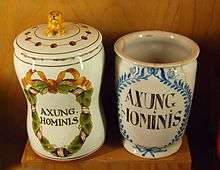Human fat
- This article deals with the pharmaceutical uses of human fat. For a general view, see Adipose tissue.



Human fat (German Menschenfett, Latin Axungia hominis) was mentioned in European pharmacopoeias since the 16th century as an important fatty component of quality deemed ointments and other pharmaceuticals in Europe. In old recipes human adipose tissue was mentioned as Pinguedo hominis, or Axungia hominis (abbrev. Axung. hominis), besides other animal fats from bears (Axung. ursi), vipers (Axung. viperarum), beavers (Axung. castoris), cats (Axung. Cati sylvestris) and many others.[2] The German medicinal Johann Agricola (1496–1570) described the recovery of human fat and its applications.
In traditional medicine in Europe, human fat was believed to have a healing magic significance until the 19th century. Many executioners recovered the fat called "Armsünderfett" or "Armsünderschmalz" (German for fat or grease from poor executed sinners) from the bodies of their executants and sold it.[3] For some executioners the marketing of human fat was a major source of revenue.[4] In traditional medicine many other parts of executed bodies as well as their fat were awarded a special action force, which evolved from a pagan sacrificial belief. The human fat was used to make ointments for treatment of various diseases such as bone pain, toothache and gout. It was also regarded as a panacea for particular diseases are associated with cachexia (e.g. tuberculosis).[5] Also an analgesic effect in rheumatoid arthritis was given to human fat.[6]
Since the late 19th Century, human fat, were produced and offered under the trade name Humanol as a sterile, liquified preparation for injections in Germany. In 1909 it was introduced for surgical treatment of scars, wound disinfection, and wound revisions. In the 1920s it became out of fashion after low cure rates and the incidence of fat embolisms caused by its application.[7] Dr. Rudolf Spanner, director of the Danzig Anatomical Institute set up a process to produce soap from human fat in 1943-44 and a limited quantity of the soap was produced on his order to clean autopsy rooms.[8] Suggested sources for the fat include Stutthof concentration camp, Danzig Municipal Jail, and a Danzig psychiatric hospital.[9] Until the 1960s various manufacturers offered alleged wrinkle creams for external use (Hormocenta of Hormocenta Cosmetic Böttger GmbH, or Placentubex C of Merz Pharmaceuticals) containing human fat from placentas collected from midwives and obstetric departments for industrial purposes. The use of human placentas was terminated in favour of animal products. In Peru a group of gangsters called pishtacos was accused of having manufactured and marketed human fat, the case turned out as a free invention of the investigators.[10]
Myths

In Spanish (sacamantecas) and Peruvian (pishtaco) folklores, there are monsters or criminals who murder for human fat. Manuel Blanco Romasanta[11] (1809-1863), the first serial killer documented in Spain, was accused of extracting fat from his victims to sell in Portugal an ounce of fat for an ounce of gold. In modern times, the belief is rationalized that the fat is used to grease bells for better sound, or for modern machinery like railways or airplanes.
References
- ↑ Collection of hamburgmuseum, Hamburg, Germany
- ↑ Ferdinand Giese: Chemie der Pflanzen- und Thierkörper in pharmazeutischer Rücksicht. Hartmann, Leipzig 1811, p. 337 (German)
- ↑ Christiane Wagner, Jutta Failing: Vielmals auf den Kopf gehacket … In: Galgen und Scharfrichter in Hessen. Naumann, Nidderau 2008, ISBN 978-3-940168-17-7 (German)
- ↑ Menschenfett war früher ein begehrter Rohstoff. In: Die Welt dated 20. November 2009, ISSN 0173-8437
- ↑ Adolf Wuttke, Detlef Weigt (Edts.): Der deutsche Volksaberglaube der Gegenwart. Superbia, Hamburg 1860 (German)
- ↑ Philip Bethge: Die Heilkraft des Todes. In: Der Spiegel. Vol. 63 (2009), No. 5 of 26. January 2009 (German)
- ↑ H. Koch: Fettembolie durch Humanolinfektion. In: Deutsche Zeitschrift für Chirurgie. Vol. 186 (1924), pp. 273–278 (German)
- ↑ Nałkowska, Zofia (February 2000). Medallions (Jewish Lives). Diana Kruprel (trans.). Northwestern University Press. ISBN 0-8101-1743-6.
- ↑ "Soap made from human remains". Nizkor. Retrieved 2006-12-29.
- ↑ ""Körperfett-Morde" stürzen Polizeichef" (in German). 2 December 2009. Retrieved 3 December 2009.
- ↑ “O HOME DO UNTO”, Romasanta, memoria cierta de una leyenda, Xosé Domínguez. Quotes
- Vicente Martínez-Risco Agüero, Discurso de ingreso en la Real Academia Gallega, Editorial Moret, La Coruña, 1971
- Document by the mayor of Nombela, partido judicial of Escalona, province of Toledo. Part of the cause against Romasanta.